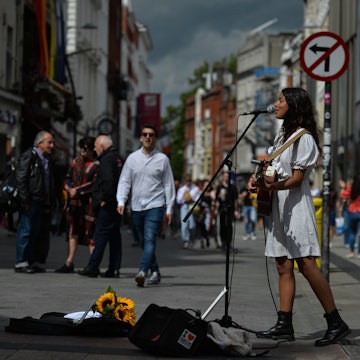

When I travel, my default fragrance is the citrusy smell of disinfectant. I’m the fidgety train passenger who slathers their hands with hand sanitizer. The fussy person on the plane who cleans their tray table with anti-bacterial wipes. Do these habits mean I’m well-prepared, anxiety-prone, or waging an unwinnable war against legions of microorganisms? Maybe all three.

Despite my germaphobic rituals, I still occasionally succumb to coughs, colds or gastric upsets when I’m on the road. Wondering whether to invest in a hazmat suit, I asked the experts: what does science say about reducing the risks of getting sick when traveling?
Do flight wipes work?
Supermodel Naomi Campbell’s pre-flight routine involves gloves and disinfectant wipes, and she isn’t alone. It’s increasingly common to see plane and train travelers cleaning the area around their seat, hoping to avoid picking up a bug from their tray table, arm rest or screen. It sounds sensible enough, when you consider how many other passengers (and their grubby hands) have passed through, but is this kind of clean-up effective?
“It’s not wrong to wipe these things down, but it’s probably unnecessary,” says David Denning, Professor of Infectious Diseases in Global Health at the University of Manchester. The likelihood of transmitting microorganisms comes down to their numbers and how long they can survive outside the body, and in this scenario both are likely to be low. If you’re inclined to clean, wiping down surfaces might reduce the risk of contracting some illnesses, but your likelihood of falling ill probably doesn’t hinge on it.
“Norovirus and rotavirus [both contagious viruses that can cause vomiting and diarrhea] are transmitted on hands and surfaces,” explains Professor Denning. “Most of these viruses don’t last very long on those surfaces. The chance of catching a cold or a diarrheal illness from the plane or from a train carriage itself is low.”
Some travelers avoid germy on-board toilets and try to remain in a window seat for the whole journey, the logic being that aisle seats receive more contact, and more potential contamination, from other passengers. This tactic could be reassuring, but on long plane journeys it runs counter to other health advice. Regularly moving around reduces the risk of deep-vein thrombosis, when blood clots can form and potentially travel to the lungs – a much more significant health threat than catching a sniffle.
Read more: How a pulmonary embolism nearly canceled my honeymoon

How to avoid getting sick on a plane
Many air travelers get a sinking feeling when they hear an eruption of coughing nearby. But don’t panic right away: you might be hearing the symptoms of asthma, allergies or various non-contagious chronic coughs.
However, if you’re on a plane seated close to a flu-ridden passenger, there’s a risk of contracting their illness. The sound of ‘productive’ (chesty, phlegmy) coughs and sneezes from someone next to you or directly behind is your cue to see if it’s possible to move to a different seat. “You want to sit behind that person rather than in front of them, because they’re projecting their viruses that way,” advises Professor Denning.
The airborne particles ejected by patient zero will fly all over the place, and attempting to use clothing or a surgical mask to shield your face from spluttering sneezes will have little to no effect. The best line of defense is frequently washing your hands with soap and water. People generally touch their hands to their face more than three times an hour, which can transmit bugs directly to their mouth, nose or eyes.
Hand sanitizer can help
The popularity of hand sanitizer has sky-rocketed in recent years. It makes up a global market of US$2.4 billion (and rising) and it’s increasingly part of travelers’ toolkits. Washing your hands thoroughly with soap and water is still the most effective way of ridding your hands of bacteria and viruses, but a squirt of microorganism-killing gel is a convenient prelude to eating and drinking on the road, especially where hand-washing facilities aren’t available.
What about the nay-sayers, who warn that being overly attentive to cleanliness is helping to create superbugs, bacteria that develop resistance to antibiotics? Is there a risk that travelers like me, with our liberal dowsings of antibacterial gel, are in fact creating a training ground for superbugs to thrive?
“It is unlikely that exposure to alcohol hand rub will select superbugs,” says Professor Laura Piddock of the University of Birmingham’s Institute of Microbiology and Infection. “However, it should be noted that no hand rub will completely eradicate microbes from the skin. Therefore, reducing the likelihood of eating or drinking contaminated food or drink requires common sense.”
Many brands of hand sanitizer claim to deactivate 99.9% of viruses, but laboratory tests take place on inanimate surfaces, not on multi-textured hands. As with good hand-washing etiquette, sanitizer is only effective if you apply it thoroughly (watch the spaces in between your fingers). And what you eat when you travel is just as important as keeping your hands clean.
Read more: 10 wellness retreats to recharge for 2020

How to avoid (or endure) food poisoning
Whether it’s growling guts or a nasty bout of vomiting and diarrhea, very few frequent travelers manage to entirely avoid stomach troubles. There are numerous ways to contract one of these bugs: dirty cutlery, contaminated swimming pools, ice cubes of unknown origin, and even the tap water used when brushing your teeth.
Food is a significant risk factor, and it’s a good strategy to choose hot and freshly cooked options (and to avoid salads and fruit that can’t be peeled). Try to assess how hygienic a food stall or restaurant is: check whether raw meat is being kept separately, whether the vendor is washing their hands or using gloves (rather than handling money and food interchangeably), whether surfaces are kept clean (or are mopped down with the same dirty cloth), and whether food is being cooked to order (or standing around unrefrigerated). Also beware touring street-food stalls after dark, as it’s much more difficult to assess whether food has been thoroughly cooked.
“E-coli causes horrible things like hemorrhagic colitis and kidney disease, and incredibly small numbers of bacteria can cause those diseases,” explains Professor Denning. “And they’re all meat-related, and meat-product related. So a veggie and fruit diet is much safer.”
Many travelers carry antibiotics to use if they contract a stomach bug, but don’t reach for them too quickly. The antibiotics may not be the right ones for the illness you’ve caught. Additionally, the drugs have an impact on your intestinal flora, which play an important role in the healthy functioning of your gut – using antibiotics for mild ailments may even raise your chances of succumbing to another gastric illness.
“You really don’t want to take an antibiotic unless you’ve had quite a lot of diarrhea or you’ve been ill for a day, or two days,” warns Professor Denning. “You may be taking something that destroys your good flora and doesn’t do anything to the bugs.”
Even travelers taking the utmost care with what they eat may still end up scurrying sweatily to the nearest toilet. It isn’t necessarily because food hygiene standards are lower in your travel destination, but simply that your body isn’t used to local bacteria. Sometimes, with a little help from electrolyte-rich drinks and plenty of rest, a traveler simply has to admit defeat and let diarrhea, ahem, run its course.

How to fight germ-anxiety and see the world
For worriers like me, who google the microorganisms that might lurk in food stalls or public bathrooms, it can be easy to let anxiety overhang a trip. Meanwhile, world travelers who have a medical background are much better able to balance sensible health precautions with seizing the day (without “sneezing” the day).
“We know more about the real risks and become quite militant about them: vaccinations, antimalarials, avoiding mosquito bites, safe drinking water, thorough hand washing, etc,” says Abigail King, a doctor-turned-writer who runs luxury travel blog Inside the Travel Lab. “But that allows us to relax where others stress! We also know full well how many risks wait at home, so aren’t put off by lists of risks when traveling abroad.”
Travelers should strive for preparedness without panic, as exploring the world inevitably brings situations that are beyond a person’s control. Armed with hand sanitizer and a little more knowledge, my immune system and I are all set for travel’s roller-coaster ride.














